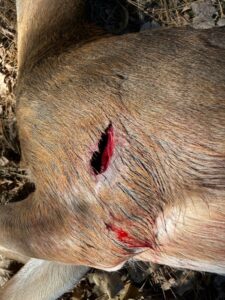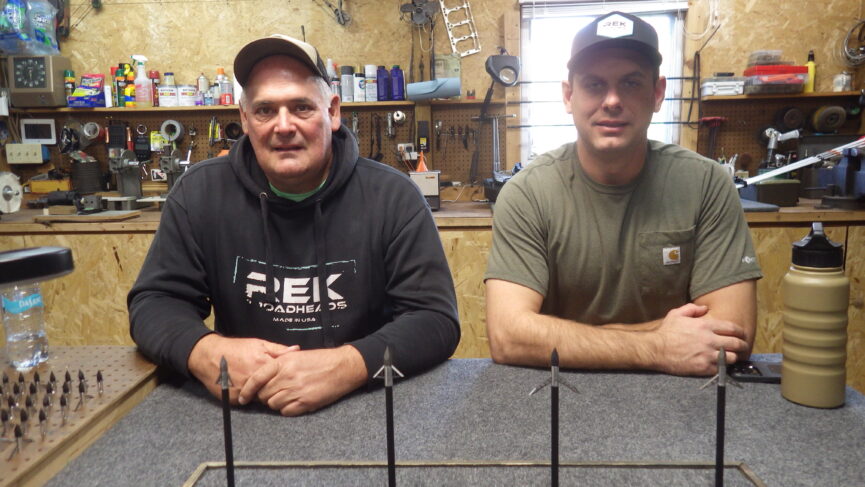Being able to create fire was, without question, the main element for helping prehistoric humans to begin climbing up the food chain. Creating fire may have led to another advancement, the creation of the bow and arrow. I can easily see a “Firestarter” using the bow and stick used for drilling into a piece of wood to create friction and thus fire, playing around with matters once a fire was created. It would be discovered the bow could cast the starter- stick quite a way, and the lights came on to create a larger version for more effective hunting.
Probably by that time, it had been discovered that a spear tipped with some sort of sharpened spearhead was far more effective at downing game than just a sharpened stick, and the same would be applied to the newly discovered arrows. As with the spearheads, stone, such as flint, chert and obsidian, which could be flaked into shape (known as knapping) was used for arrowheads. It was once thought that knapping stone into useful items (including knives and other useful tools) was a lengthy process, but I watched a modern-day “knapper” turn a piece of chert into an arrowhead in just a few minutes. The key was being able to read the grain of the stone and begin flaking (aka chipping) in a constructive manner.
Arrowheads would follow the history of humankind with the materials being used in their construction, such as copper, bronze, iron and eventually steel. Although Native Americans continued to make and use stone arrowheads right into the 19th Century, they didn’t hesitate to use the more modern metals brought in by Europeans, and forged iron arrowheads were often a popular trade item, along with knives, axes, pots and pans.
I’ve been an avid bowhunter for over six decades and have seen the evolution of modern steel arrowheads (aka broadheads), featuring some intriguing and interesting designs. One was Browning’s “Serpentine” which came out in the 1970’s and was designed to cut a big “figure 8” when it hit home. An advertisement even featured an apple with a sizeable figure 8 -hole slicing through it, and after checking one out at a local archery shop, I was a bit skeptical, to say the least. An apple with a thin skin and soft core, doesn’t compare to hair-covered hide, followed by fat, flesh and often bone (per the ribcage), and proper penetration would be very questionable. Nope, folks, I didn’t even consider giving the Serpentine broadhead a try, I didn’t know of any deer taken with one, and it was soon off the market for obvious reasons.
An early favorite of mine was a 3-blade “Bodkin” which is sturdy, easy to sharpen and penetrates well. My most used is the 2-edged Bear “Razorhead” which featured a small, replaceable “bleeder-blade” designed to create a more effective slice. However, I never liked that bleeder-blade because it had the brittle and thin texture of a razorblade and could easily shear off when impacting bone. I know meatcutters who were none too happy about encountering a sheared off bleeder-blade, especially with a saw. I simply left my Bear Razorheads as a two-edged broadhead, used only a “fine” file to sharpen it to leave a coarser edge for cutting through matters, and I would also file the tip into a small wedge for piercing through bone. Yep, folks, I frequently had complete “pass-throughs”, short blood-trails and it is a broadhead I still depend upon with my traditional tackle. And I always use wooden arrow shafts, because they do an admirable job.
Another broadhead I appreciate is a hefty two-edged Zwickey, which I used with my longbow to down a dandy caribou bull in the Arctic, and it does wonders on deer as well. However, when I ventured into compound bows and crossbows, I began using the modern broadheads with multiple replaceable blades. My favorite has long been a 3-bladed Muzzy, which has always performed nicely on deer, as well as a sizeable Ontario black bear.
Being old school and fond of dependable “fixed blade” broadheads, I’ve been somewhat skeptical about the popular expanding mechanical versions, mainly regarding penetration, not to mention the possibility of opening before impact. I know plenty of bowhunters who appreciate their expandable broadheads due to impressive entry and exit holes, so the facts speak for themselves, and I’m probably going to give them a whirl, especially with a relatively new “Made in Michigan” broadhead. I had recently heard of REK (which stands for wrecking anything in its path) Broadheads manufactured near Bridgeport, and that I liked what I read about them, and which is why I recommended them to my son Joshua who wanted to try a mechanical broadhead with his Darton crossbow. The set of 3 broadheads he ordered were REK’s new this year “HXP” 100-grain which offers a 2 ¼-inch cut but was noted for making a 3-inch slice upon entry due to what is called a “slap-cut”, and then going back to 2 ¼ inches as it passes through.
Josh soon found himself in a ladder-stand at first light overlooking a goldenrod -filled clearing with his crossbow at the ready when a tall-tined fork-horn buck stepped into view and stopped broadside at 45 yards. Josh quickly took aim and touched the crossbow’s trigger and heard a loud smack as the bolt hit home, followed by the buck leaping away and then going down. I went in to assist Josh in field dressing and getting the buck out and was indeed impressed with what I discovered.
Josh had intended to hit the buck just behind the shoulder but ended up hitting the shoulder dead-center, not always the best location to hit with a bolt or arrow. However, the entry hole was a distinct 3-inch gash, with the bolt passing right through and leaving a similar-sized exit hole out the other shoulder. The bolt had also kept going, and in the waist-high goldenrod was never seen or recovered again, despite an intense search!
Yep, folks, that buck was stone dead as found and I was impressed and have an attitude adjustment. That is an expandable broadhead which really works as advertised.

Pics by Josh Lounsbury of his fully broadside buck he shot at 45 yards in the left shoulder with his Darton Crossbow using a bolt tipped with the new 100-grain REK HXP expandable broadhead. The 3-inch “slap-cut” is clearly visible and the exit wound out the right shoulder was nearly identical. The bolt kept going after passing through both shoulders, and was never seen again in the waist-high goldenrod! Yep, the buck didn’t need much tracking afterwatrds….
I recently contacted REK to discuss matters. It is purely a family-owned business with Steve Taggett, father, who after 42 years’ experience as an engineer designing matters, teamed up with his son, Matt, to make a better expandable broadhead, not to mention Kim, mother, who handles shipping, receiving, bookwork and all, and they all work together assembling matters. Steve and Matt are a father and son team who hunt several states seeking big whitetail bucks, using identical Matthew’s compound bows, and they knew there had to be something better when it came to the expandable broadheads they were using, and they then decided to use their own design. In 2018, Steve came up with a design which he and his son field-tested, and it did the job they required, and in 2019 they started to field test and “tune” it further. They brought it out in 2020, but a day later, Covid 19 restrictions came into effect, and matters became a word of mouth and available online-only. However, by 2022, they were back in the game with many distributors today featuring their REK broadheads, including fixed-blade designs.
Yep, folks, Made in Michigan sure works for me!
- Fickle weather during December deer hunting adventures - December 3, 2025
- Michigan’s most popular opening day – November 15th - November 23, 2025
- A missing dog found while anticipating opening day - November 23, 2025

